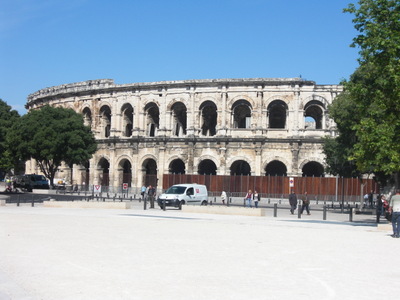
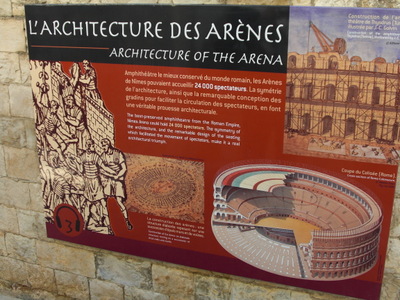 So we started with the amphitheater, seen here from the plaza at the to of the pedestrian boulevard. It's considered the best preserved of all Roman arenas in the world, and like the less-well-preserved ones, it's still in routine use.
So we started with the amphitheater, seen here from the plaza at the to of the pedestrian boulevard. It's considered the best preserved of all Roman arenas in the world, and like the less-well-preserved ones, it's still in routine use.Monday, 27 May 2013: Nîmes, the truth about gladiators
Written Wednesday, 12 June 2013
When we bought our tickets to tour the Roman theater in Orange, we opted for the bundled ticket that would also be good for admission to the amphitheater in Nîmes, where we knew we would shortly be going. Monday morning, when we presented our tickets at the amphitheater, we learned that they were in fact good for all three of the major Roman sites in the city: the amphitheater, the Maison Carré, and the Tour Magne (the ruined tower at the top of the hill behind the big city park). Good deal! We never did climb up to the tower, but I studied it through binoculars from my hotel-room window.

 So we started with the amphitheater, seen here from the plaza at the to of the pedestrian boulevard. It's considered the best preserved of all Roman arenas in the world, and like the less-well-preserved ones, it's still in routine use.
So we started with the amphitheater, seen here from the plaza at the to of the pedestrian boulevard. It's considered the best preserved of all Roman arenas in the world, and like the less-well-preserved ones, it's still in routine use.
On the right is a panel diagramming the structure's architecture, which is essentially the same as that of the Colosseum in Rome (those Romans really loved their arches) and illustrating the wedge-shaped retractable canvas shades that could be deployed to protect the spectators.
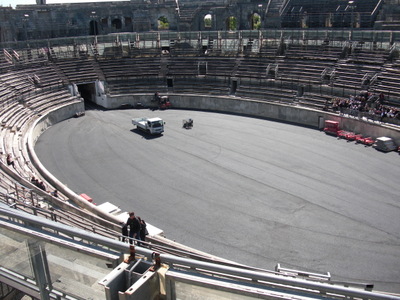
 These inside views show that wooden seats have been added, so spectators no longer sit directly on the stone risers. The arena floor has been tarmacked over, but signs at the entrance hasten to tell the visitor that they do that every summer, to protect the original surface underneath, and that the tarmac is removed again every fall.
These inside views show that wooden seats have been added, so spectators no longer sit directly on the stone risers. The arena floor has been tarmacked over, but signs at the entrance hasten to tell the visitor that they do that every summer, to protect the original surface underneath, and that the tarmac is removed again every fall.
When we were there, they were setting up for bullfights—you can see the stacks of red and white planks and boxes that will be assembled into the protective barriers around the sides. Nîmes is one of the few cities in France where old-fashioned blood-sport bullfighting is still allowed, and one of the several small museums housed within the amphitheater is devoted to it, both the traditional blood sport and the Camargue style, in which the bull is armed (with horns) but the bullfighters aren't. I much prefer the latter, not just on moral grounds but as a spectator sport. A group of several young men dressed in natty tennis whites share the arena floor with the bull and take turns attempting to snatch off, by hand, a small rosette tied to the bull's forehead, between the horns, and to live to tell the tale. Mostly, they do a little feinting to distract the bull, make the grab, and then scramble like heck for the boards, which they vault over, inches ahead of the horns, often clinging to the iron railing confining the spectators, as the bull tries to get over the boards behind them. We've never seen either kind live, but the museum provided lots of film footage.

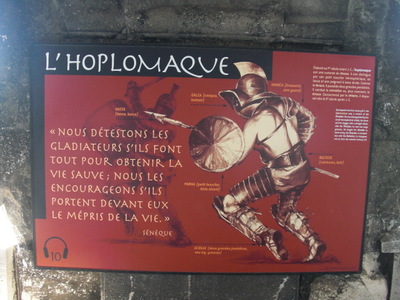 The most amazing and informative section of the tour, though, was the extensive audioguide entries and explanatory panels about gladiators. First, the audioguide explained at length the components of a day of games in the Roman arena. It would begin in the morning with fights between wild animals—a bull and a bear were one popular combination; another was a bear baited by a pack of dogs. Next would come "hunts," in which men—armed and well trained— were pitted against animals, trying to kill them without being killed.
The most amazing and informative section of the tour, though, was the extensive audioguide entries and explanatory panels about gladiators. First, the audioguide explained at length the components of a day of games in the Roman arena. It would begin in the morning with fights between wild animals—a bull and a bear were one popular combination; another was a bear baited by a pack of dogs. Next would come "hunts," in which men—armed and well trained— were pitted against animals, trying to kill them without being killed.
Over lunch, condemned criminals were put to death, sometimes by being turned over, unarmed or even bound, to wild animals. This section was apparently the least well attended.
Finally, in the afternoon, came the main event, human-on-human fights between gladiators. First, the fights were rarely to the death. They were refereed, usually by a retired gladiator skilled at spotting signs of collusion between combatants, and an arbiter declared the winner and ruled on whether the loser should die. Usually the loser was spared, unless he'd shown signs of cowardice (i.e., spending too much time and energy on defense and not enough on offence). Second, the gladiators were not slaves, prisoners, or other expendables—they were highly, and expensively, trained fighters who chose to be there. Nobody wanted to watch amateurs slaughter each other; the spectators were connoisseurs of fighting technique. As in modern boxing, they really were trying to hurt each other and sometimes succeeded, but the referee kept things fair, and usually nobody died.
Most amazing of all was the series of illustrated panels, just two of which I show above, explaining the different types of gladiators, seven in all: Provocator, Thrace, Hoplomaque, Mirmillon, Rétiare (he's the one with the net and the trident), Secutor, and Arbelas. Most beginning gladiators started out as Provocators—dagger, large shield, one shinguard, one armored sleeve, one shoulder pad. The few women gladiators were mostly Provocators. With additional experience, they might move up to one of the other types, which differed in their protection and armament: large sword or small, large shield or small, full helmet or iron cap, one shin guard or two (large or small), amount of armor from full body suit to almost nothing (like the Rétiare), plates versus mail armor, etc. The Arbelas even wore a sort of cuff that covered the left hand and ended with a half-moon-shaped cutting blade. Different spectators had different favorite match-ups, Provocator versus Mirmillon, Hoplomaque versus Rétiare, etc.
The small gladiator museum included three film clips considered to reflect the truth about gladiatorial combat fairly well—two modern documentary reenactments and a scene from Spartacus featuring Kirk Douglas and Woody Strode.
Panels also displayed a selection of epitaphs from the tombs of individual gladiators, sometimes commissioned by their instructors or fellow gladiators.
Still others illustrated various types of Roman stadiums, for foot races, chariot races, etc., and even one amazing aquatic stadium on the banks of the Tiber large enough to stage naval battles involving 20 galleys!
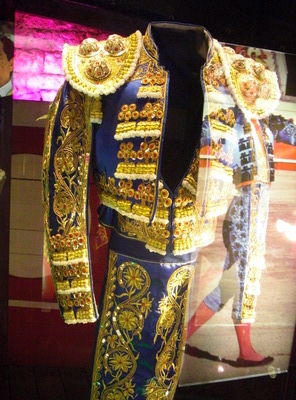

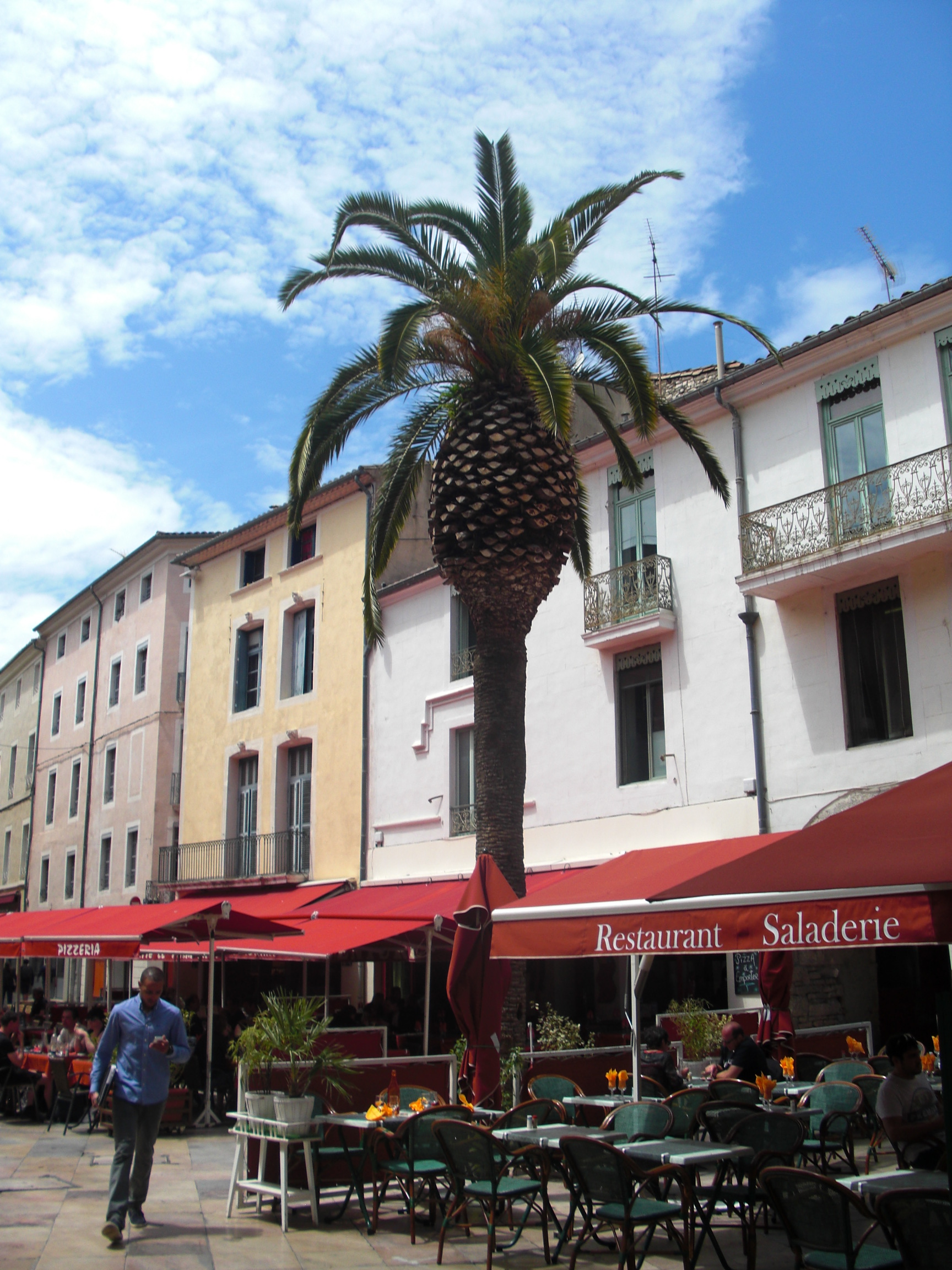 Finally, here's one of the incredibly intricately decorated bullfighters' suits (left) on display in the museum. Outside the amphitheater is this statue (center) of Nimeño (i.e., "little Nîmes guy), a particularly beloved bullfighter. Someone had put fresh flowers on it. At the right is the palm tree in the Place du Marché, carefully chosen to match the one depicted on the city's seal.
Finally, here's one of the incredibly intricately decorated bullfighters' suits (left) on display in the museum. Outside the amphitheater is this statue (center) of Nimeño (i.e., "little Nîmes guy), a particularly beloved bullfighter. Someone had put fresh flowers on it. At the right is the palm tree in the Place du Marché, carefully chosen to match the one depicted on the city's seal.
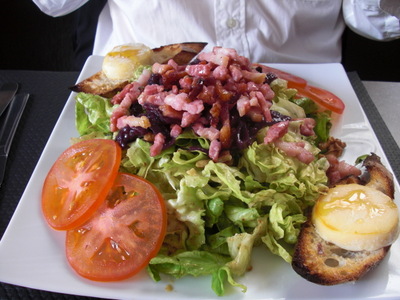
 We had lunch within sight of the palm and the crocodile at Le Mogador.
We had lunch within sight of the palm and the crocodile at Le Mogador.
David had a goat-cheese salad with stewed red onions and lardons. For once, the excellent goat cheese was grilled on good old baguette slices before being drizzled with honey.
I had a similar salad but topped instead with slices of magret de canard, cold foie gras, and a wonderful heap of whole confit chicken gizzards, also with baguette toast. Delicious.
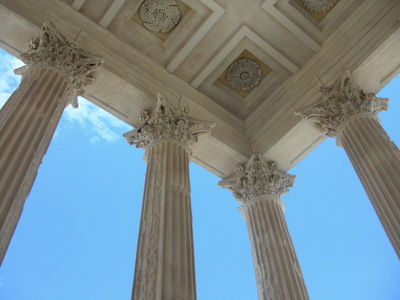
 After lunch, we went up to the Maison Carréto see the film running continuously there. This view (left) is of a corner of the ceiling of its porch. Around the outside of the building, you can see the bases of the columns outlining the courtyard that surrounded it.
After lunch, we went up to the Maison Carréto see the film running continuously there. This view (left) is of a corner of the ceiling of its porch. Around the outside of the building, you can see the bases of the columns outlining the courtyard that surrounded it.
Then we walked around the old town reading historical markers until our feet were tired. To rest them, we went back to the Place du Marché for a hot chocolate (for David) and a mineral water (for me) and people-watched from the sidewalk tables of the Courtois, a self-styled "historic café." Then it was back to the hotel to get ready for dinner, David directly and me via a large post office we had spotted on the way out. I still send a few postcards from France, to people who don't have internet access and therefore can't read my blogs, and my friend Françoise pointed out to me years ago that the French post office sells prestamped envelopes, singly and a little cheaper in packets of 10, that will take up to 20 g of anything flat (e.g., a couple of postcards, a postcard and a souvenir brochure, or several sheets of typing paper) anywhere in the world and are cheaper than the stamps for a postcard! She and I therefore send our postcards in those envelopes—you can write all over the postcard, including the address space, and the envelopes are like forever stamps; they never expire even if postage rates change. They also sell cheaper forever envelopes that will take 20 g anywhere within the EU. This year, my left-over supply of international envelopes came up one short of our needs, so I bought a new packet of 10, for 10 euros.
Back at the hotel, I addressed David's last postcard and went out to mail it at the train station. On the way back, I spotted a Carrefour City around the corner from the hotel! Carrefour (which means "intersection") is the best (to my way of thinking) hypermarket in France. They have everything, and of very good quality. They're usually out in the suburbs, the size of super-Walmarts, with big parking lots, but the last few years, they've branched out into little urban "convenience store" versions called Carrefour City. I'd never had a chance to explore one, so I went in to look around.
The difference between what the French and the Americans consider to be the essential stock of a convenience store is astounding. The cheese selection was the size of the one at Publix, and with better variety and better cheese. I found packaged slices of smoked duck magret; both cans and plastic packs of confit gizzards and chicken livers; several flavors of ready-cut, ready-to-cook lardons; whole raw fresh duck breasts; raw quail eggs by the dozen; fresh and dried sausages; ready-made, ready-to-fill crepes, both sweet and savory (the latter made with buckwheat); raw and cooked sliced ham; glass jars of several kinds of paté; cans and jars of duck and goose confit; cans and jars of ready-made cassoulet; fresh veal, veal liver, lamb, chicken, turkey,and rabbit; cans and squeeze tubs of chestnut cream; every flavor of Bonne Maman jam ever made (including many we can't get in the US), plus Bonne Maman single-serve refrigerated desserts (crème caramel, lemon pie, strawberry cream cake—with fresh strawberries—rum baba) and jars of Bonne Maman fruit compotes (apricot, peach, rhubarb); a very nice selection of high-quality, famous-name butters; lots of prepared foods in microwavable single-serve packs (tartiflettes, chicken with rice, rabbit with mushrooms, lasagne, shepherd's pie, chicken curry); cans of couscous (triple packs&mkdash;one can of stewed meat and veggies, another of steamed couscous, and a little separate seasoning packet with which you could season the stew as highly as you liked); a very broad selection of shelf-stable cream soups in "milk cartons"; and of course, a few fresh vegetables, eggs, milk, bread, beer, wine, crackers, cookies, candy, etc. And this is a crummy convenience store!

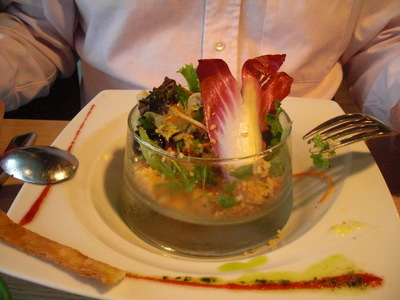 For dinner, we might have walked to Brasserie l'Annexe, but it was 2.5 km away, and rain was threatening, so we took a cab. The brasserie was right across from a large sports complex, but apparently nothing was going on there that night.
For dinner, we might have walked to Brasserie l'Annexe, but it was 2.5 km away, and rain was threatening, so we took a cab. The brasserie was right across from a large sports complex, but apparently nothing was going on there that night.
Amuse-bouche: Seasoned fromage blanc with toasts.
First course, David: Vegetable tabouleh with diced chicken and lemon. The tabouleh was based on couscous (as most are in France), which had been cooked with a tomato broth and was very flavorful in own right, and as you can see, a whole variety of crispy veggies had been added on top. The chicken in was in the bottom, with diced bits of preserved lemon. Very good.
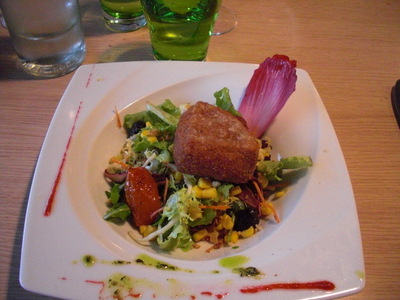
 First course, me: A small salad full of corn, olives, shredded carrot, bits of dried fruit, and confit tomatoes and topped with a breaded and fried wedge of Camembert. Also very good. I could easily do this at home.
First course, me: A small salad full of corn, olives, shredded carrot, bits of dried fruit, and confit tomatoes and topped with a breaded and fried wedge of Camembert. Also very good. I could easily do this at home.
Main course, David: Gambas grilled on the flattop accompanied by an herb risotto, thin flakes of Parmesan, and a "Noilly Prat emulsion." Herbed oil drizzled around the outside of the plate. He ate the gambas, but he can't be bothered to extract the meat from the last segment of the tail, so I got those!

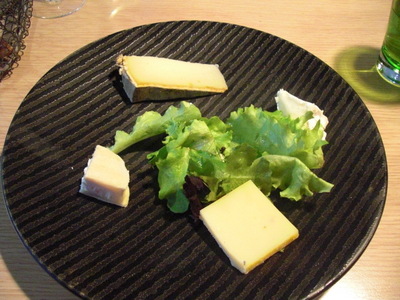 Main course, me: Beef tartare. Not such a much. Why do they put so much pickle in it?! You could hardly taste the beef, although adding a little Worcestershire helped. The fries were also pretty cardboardy, and the piece of "toast" on top of the beef was weird—it was perfectly dried out and crisp but also perfectly white (except where drizzled with herbed oil). And when I asked for mayo for the fries, they brought a glass filled with little single-serve packets of mustard, ketchup, and mayo. David commented that they're never going to get a Michelin star doing that . . .
Main course, me: Beef tartare. Not such a much. Why do they put so much pickle in it?! You could hardly taste the beef, although adding a little Worcestershire helped. The fries were also pretty cardboardy, and the piece of "toast" on top of the beef was weird—it was perfectly dried out and crisp but also perfectly white (except where drizzled with herbed oil). And when I asked for mayo for the fries, they brought a glass filled with little single-serve packets of mustard, ketchup, and mayo. David commented that they're never going to get a Michelin star doing that . . .
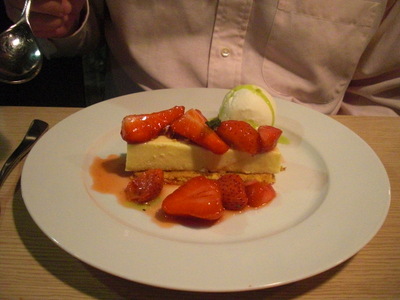
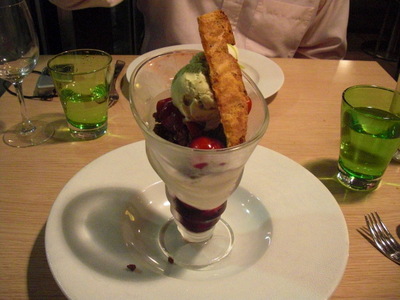 Dessert, David: a "tartlet" consisting of a shortbread cookie topped with vanilla mousse, a ball of yogurt ice cream, and lightly stewed strawberries.
Dessert, David: a "tartlet" consisting of a shortbread cookie topped with vanilla mousse, a ball of yogurt ice cream, and lightly stewed strawberries.
Dessert, me: Cherry "freshness": mascarpone, chocolate cookie crumbles, outstanding pistachio ice cream, stewed morello cherries, and fresh black cherries. Excellent (if the cookie crumbles hadn't been quite so hard).
Outside, in the gathering dusk, while we ate, a small group of roller-bladers assembled and then set off. We've often encountered that phenomenon in Paris, where skaters assemble hundreds strong and then roam the city by night, led and accompanied by uniformed police on skates and followed a dozens of sympathizers on bicycles. Those groups tend to include a lot of young people and 20- and 30-somethings, but this one—only a dozen or so skaters—ran heavily to wiry, grizzled, 60-year-old men!